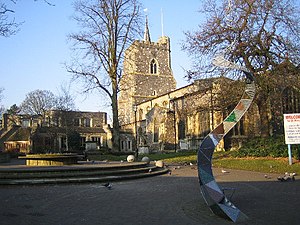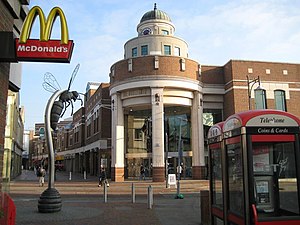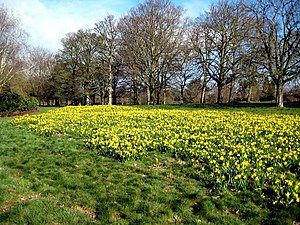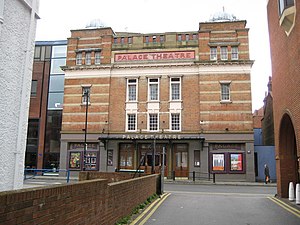Watford
| Watford | |
| Hertfordshire | |
|---|---|
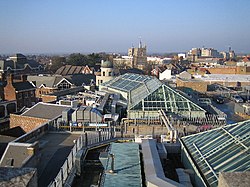 Watford roofscape | |
| Location | |
| Grid reference: | TQ110963 |
| Location: | 51°39’17"N, 0°23’45"W |
| Data | |
| Population: | 80,000 (2001) |
| Postcode: | WD |
| Dialling code: | 01923 |
| Local Government | |
| Council: | Watford |
| Parliamentary constituency: |
Watford |
Watford is a large town in Hertfordshire and the county's biggest commercial centre. Official estimates in 2006 put its population at 79,600.
Along with nearby villages such as Croxley Green, Bushey, Rickmansworth, and Abbots Langley, it is within the ring of the M25 motorway but distinct and separated from the vast conurbation to the south.
Contents
History
Origins
Watford stands on a low hill near the point at which the River Colne was forded by travellers between London and the Midlands. This route, originally a pre-Roman trackway, departed from the ancient Roman Watling Street at Stanmore, heading for the Gade valley and thence up the Bulbourne valley to a low and easily traversed section of the Chiltern Hills near Tring. The modern High Street follows the route of this road, as does the A41.[1][2]
The ford was close to the later site of a gas works site.
The town probably originated in Anglo-Saxon times as a string of houses on the northern side of this ford. It was located on the first dry ground above the marshy edges of the River Colne. It is generally agreed that the town is named after the ford, but the origin of the first part of the name is uncertain. Theories include the Old English words wæt (wet), wadan (walk, wade), watul (wattle, a fence) or wath (hunter), Watling Street, and a hypothetical Saxon landowner called "Wata".[2]
Early history
Watford is first mentioned in an Anglo-Saxon charter of 1007. It does not get a mention by name in the Domesday Book, but was included in the entry for the then more important settlement of Cashio which stood half a mile away at the crossroads of the St Albans road and Hempstead road near the modern Town Hall.[3]
The settlement's location helped it to grow, since as well as trade along this north-south through route it possessed good communications into the vale of St Albans to the east and into the Chiltern Hills along the valley of the River Chess to the west. In 1100 Henry I granted a charter to Watford to hold a weekly market.[1]
The parish church of St Mary the Virgin was built in 1230 on the same site as an earlier Saxon church. It was extensively restored in 1871.[4]
The great houses of Cassiobury and The Grove were built in the seventeenth centuries and expanded and developed throughout the following centuries. Cassiobury became the family seat of the Earls of Essex, and The Grove the seat of the Earls of Clarendon.[3]
The Sparrows Herne turnpike was established in 1762 to improve the route across the Chilterns, with the road maintained from charges levied at toll houses along the way. The location of a toll house can be seen at the bottom of Chalk Hill on the Watford side of Bushey Arches close to the Wickes hardware store; set in an old flint stone wall is a Sparrows Herne Trust plaque.[5]
Industrial Revolution
Watford remained an agricultural community with some cottage industry for many centuries. The Industrial Revolution brought the Grand Junction Canal (now Grand Union Canal) in 1798 and the London and Birmingham Railway in 1837, both located here for the same reasons the road had followed centuries before, seeking an easy gradient over the Chiltern Hills. The land-owning interests permitted the canal to follow closely by the river Gade, but the prospect of smoke-emitting steam trains drove them to ensure the railway gave a wide berth to the Cassiobury and Grove estates. Consequently, although the road and canal follow the easier valley route, the railway company was forced to build an expensive tunnel under Leavesden to the north of the town. The main Watford railway station was and remains outside of the town centre to the east at Watford Junction.[6]
These developments gave the town excellent communications and stimulated its industrial growth during the nineteenth and twentieth centuries. The Grand Union Canal, allowed coal to be brought into the district and paved the way for industrial development. The Watford Gas and Coke Company was formed in 1834 and gas works built. The canal allowed paper-making mills to be sited at Croxley. The John Dickinson and Co. Mill beside the canal here manufactured the Croxley brand of fine quality paper. The paper making influenced the development of printing in the town which continues today. There had been brewing in Watford from the seventeenth century and, by the nineteenth century, two industrial scale brewers Benskin's and Sedgwick's were located in the town.[7]
Economy
Watford is a major regional centre for the northern home counties. The primary shopping area is the Harlequin Shopping Centre, a large purpose-built indoor mall with over 140 shops, restaurants and cafés built during the 1990s, opened officially in June 1992.
The High Street, running through the town centre, is the main focus of activity at night having a high concentration of the town's bars, clubs and restaurants.
The head offices of a number of national companies are located in the town and around.
Plans are underway to develop a new Health Campus complete with heliport adjacent to the site of the current Watford General Hospital.
Watford Metropolitan Station by Cassiobury Park is at the outer extremity of the Watford Branch of London Underground's Metropolitan Line station at the outer north-western boundary of the Tube system. The town has two other stations though, closer to the town centre; Watford Junction and Watford High Street, both on overground lines.
Things to see in the town
Cassiobury Park
Cassiobury Park was formed from the grounds of Cassiobury House and consists of 190 acres of open space. The house itself was demolished in 1927 and the original imposing gatehouse entrance – the Cassiobury Gates – in the 1970s, due to road widening. In July 2007, the park won a Green Flag Award, which recognises the best green spaces in the country.[8] It has a children's play area which includes a paddling pool, play equipment, mini train track for children's rides, bouncy castle, ice cream van and a refreshment kiosk. The Grand Union Canal passes through the park.
Watford Colosseum
The Watford Colosseum is world renowned for its acoustic qualities, which are often said to be the best available in the United Kingdom. It was used to record sound tracks for films such as Lord of the Rings, the Sound of Music, The Star Wars Trilogy and Sleepy Hollow. Among many famous classical recordings made there is Julian Lloyd Webber's performance of Elgar's Cello Concerto, conducted by Yehudi Menuhin.
The Colosseum has given performances from world renowned performers as and continued as popular music venue until it went into administration after funding difficulties. It closed in April 2010 to undergo a major refurbishment.
Watford Palace Theatre
The Watford Palace Theatre is an Edwardian theatre, and the only producing theatre in Hertfordshire. It presents a selection of comedy, drama, world premieres, family friendly shows and an annual traditional pantomime. The theatre building is approaching its centenary and has recently been refurbished.
The Pumphouse Theatre and Arts Centre
The Pump House Theatre and Arts Centre is based in an old pumping station situated in Watford's Lower High Street. The building was converted for use as a theatre, with rehearsal rooms, and meeting place for local arts based groups. Current facilities include a 124-seat theatre, rehearsal rooms, and live music venue. Community groups currently meeting at the Pump House include Dance House (children's ballet), Pump House Clog Morris (women's Morris dancing), Pump House Jazz (jazz club), Open House (live open mic music), Woodside Morris Men (men's Morris dancing), child, youth and adult theatre groups.[9]
References
- ↑ 1.0 1.1 Samuel Lewis (ed.) (1848). "Watford (St. Mary)". A Topographical Dictionary of England (7th ed.). pp. 486. http://www.british-history.ac.uk/report.aspx?compid=51382#s1. Retrieved 2008-03-22.
- ↑ 2.0 2.1 W.R. Saunders (1931). History of Watford. Watford: Peacock.
- ↑ 3.0 3.1 William Page (ed.) (1908). "Watford: Manors". A History of the County of Hertford: volume 2. Victoria County History. pp. 451–464. http://www.british-history.ac.uk/report.asp?compid=43308. Retrieved 2008-05-19.
- ↑ William Page (ed.) (1908). "Watford: Churches and Charities". A History of the County of Hertford: volume 2. Victoria County History. pp. 464–469. http://www.british-history.ac.uk/report.asp?compid=43309. Retrieved 2008-05-19.
- ↑ Sparrow Herne Trust Turnpike Marker, Lower High Street, Watford, Images of England, English Heritage National Monuments Record.
- ↑ William Page (ed.) (1908). "Watford: Introduction". A History of the County of Hertford: volume 2. Victoria County History. pp. 446–451. http://www.british-history.ac.uk/report.asp?compid=43307. Retrieved 2008-03-22.
- ↑ "The History of Watford". Haberdashers Askes Boys School – Geography Department. 4 February 2008. http://www.habsboys.org.uk/Departments/Geography/Watford/history_of_watford.htm. Retrieved 11 August 2010.
- ↑ Cassiobury Park, Green Flag Awards.
- ↑ The Pump House Theatre & Arts Centre
Outside links
- Watford Observer Newspaper
- Watford Palace Theatre
- Watford Museum
- Watford, Hertfordshire, A Vision of Britain Through Time, Department of Geography, University of Portsmouth.
- A Short History of Watford from the Geography department of Haberdashers School Accessed October 2006
- Watford Genealogy on A Guide to Old Hertfordshire
- The Pump House Theatre and Arts Centre
- Famous Watfordians
